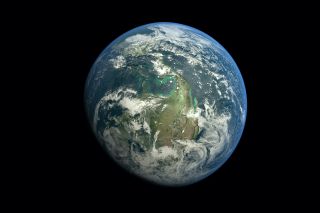50 interesting facts about Earth
From extreme climates to peculiar creatures, here are some top facts about Earth.

Did you know that our planet is rocketing around the sun at 67,000 mph? Or that it may once have been purple? Here are 50 facts about Earth.
1. We're the third rock from the sun

Our home, Earth, is the third planet from the sun and the only world known to support an atmosphere with free oxygen, oceans of liquid water on the surface and life. Earth is one of the four terrestrial planets, according to NASA: Like Mercury, Venus and Mars, it is rocky at the surface.
2. Earth is squashed

Earth is not a perfect sphere. According to the National Oceanic and Atmospheric Administration (NOAA), as Earth spins, gravity points toward the center of our planet (assuming for explanation's sake that Earth is a perfect sphere), and a centrifugal force pushes outward. But since this gravity-opposing force acts perpendicular to the axis of Earth, and Earth's axis is tilted, centrifugal force at the equator is not exactly opposed to gravity.
3. The planet has a waistline

Gravity pushes extra masses of water and earth into a bulge, or "spare tire" around our planet. At the equator, the circumference of the globe is 24,901 miles (40,075 kilometers), according to Space.com. Bonus fact: At the equator, you would weigh less than if standing at one of the poles.
4. Earth is on the move

You may feel like you're standing still, but you're constantly moving — fast. Depending on where you are on the globe, you could be spinning with the planet at just over 1,000 miles per hour, according to Space.com.
People on the equator move the fastest, while someone standing on the North or South pole would be perfectly still. (Imagine a basketball spinning on your finger. A random point on the ball's equator has farther to go in a single spin as a point near your finger. Thus, the point on the equator is moving faster.)
5. The planet moves around the sun

The Earth isn't just spinning: It's also moving around the sun at 67,000 miles (107,826 km) per hour, according to the American Physical Society.
6. Earth is billions of years old

Researchers calculate the age of the Earth by dating both the oldest rocks on the planet and meteorites that have been discovered on Earth (meteorites and Earth formed at the same time, when the solar system was forming). Their findings? Earth is about 4.54 billion years old, according to the National Center for Science Education.
7. The planet is recycled

The ground you're walking on is recycled. Earth's rock cycle transforms igneous rocks to sedimentary rocks to metamorphic rocks and back again.
The cycle isn’t a perfect circle, but the basics work like this: Magma from deep in the Earth emerges and hardens into rock (that's the igneous part). Tectonic processes uplift that rock to the surface, where erosion shaves bits off. These tiny fragments get deposited and buried, and the pressure from above compacts them into sedimentary rocks such as sandstone. If sedimentary rocks get buried even deeper, they "cook" into metamorphic rocks under lots of pressure and heat, according to Dorling Kindersley.
Along the way, of course, sedimentary rocks can be re-eroded or metamorphic rocks re-uplifted. But if metamorphic rocks get caught in a subduction zone where one piece of crust is pushing under another, they may find themselves transformed back into magma.
8. Our moon quakes

Earth's moon looks rather dead and inactive. But in fact, moonquakes, or "earthquakes" on the moon, keep things just a bit shaken up. Quakes on the moon are less common and less intense than those that shake Earth. The total seismic energy released by the moon is about 80 times less than that released by Earth, according to the Encyclopedia of Physical Science and Technology.
According to the Journal of Geophysical Research, moonquakes seem to be related to tidal stresses associated with the varying distance between the Earth and moon. Moonquakes also tend to occur at great depths, about midway between the lunar surface and its center.
9. Chile had the largest earthquake

As of March 2016, the largest earthquake to shake the United States was a magnitude-9.2 temblor that struck Prince William Sound, Alaska, on Good Friday, March 28, 1964.
The world's largest earthquake was a magnitude 9.5 in Bio-Bio, Chile on May 22, 1960, according to the U.S. Geological Survey (USGS).
10. The hottest spot is in Libya

The fiery award for Earth’s hottest spot goes to El Azizia, Libya, where temperature records from weather stations reveal it hit 136 degrees Fahrenheit (57.8 degrees Celsius) on Sept. 13, 1922, according to NASA Earth Observatory. There have likely been hotter locations beyond the network of weather stations.
Sign up for the Live Science daily newsletter now
Get the world’s most fascinating discoveries delivered straight to your inbox.

Stephanie Pappas is a contributing writer for Live Science, covering topics ranging from geoscience to archaeology to the human brain and behavior. She was previously a senior writer for Live Science but is now a freelancer based in Denver, Colorado, and regularly contributes to Scientific American and The Monitor, the monthly magazine of the American Psychological Association. Stephanie received a bachelor's degree in psychology from the University of South Carolina and a graduate certificate in science communication from the University of California, Santa Cruz.
